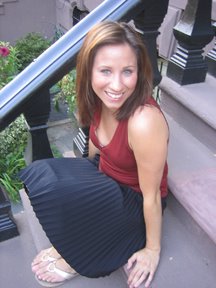Queens, New York, December 1978. I was born too early and too small. Weighing just shy of four pounds, my father said I looked like a chicken. My mother said I looked like a china doll. I’m not sure what my three-year-old sister thought of me, but I’ve heard stories about toddlers trying to put their new siblings in the trash.
Elementary school started out okay. I have a few select memories from kindergarten: a student’s grandfather, an Italian chef, coming to our class to cook squid on a hot plate; building a toy car out of pieces of wood; and putting milk money into a very, very small brown envelope.
The next few years were mostly all right. The highs included: performing as Jackie and the Beanstalk in a third-grade play, reading Choose Your Own Adventure books (and always cheating), and getting up to “knee-zies” in Chinese jump rope. The lows included: hiding in the bathroom whenever math homework was collected in the fifth grade, frequent feelings of déjà vu, and being told I had “skeleton hands” by the boy I had a crush on.
Sixth grade was the beginning of a new era—private school—where the classes were small and my inability to do math was quickly discovered. This is also when I wrote my first short story. It was based on an old photograph of a woman standing in the woods with her back to the camera. [Click the image to see it bigger.]

My teacher gave me an A, something I didn’t often get. My parents went crazy for the story, and my seeming maturity. The consensus was that I had talent. At some point in high school I started keeping a journal. Every few months I’d go to the drug store to buy a new marble composition book. I’d spend a lot of time decorating the cover with stickers, drawings, photos, and cut outs from magazines. And when I thought the cover was sufficiently cool, I’d start writing in it.
When I was a senior in high school, I took AP Writing. Our teacher required us to write ten journal pages a week. I think I was one of the few students in the class that didn’t mind. But by then I was already a journal addict. I couldn’t go anywhere without it. And if I left my notebook at home by mistake, I would write on scraps of paper, napkins, my hand, anything. (This was also the year I discovered Anais Nin--the queen of journal writing.)
There were two things I loved most about having a journal. The first was that it filled my time. Waiting for a train? No problem. Stuck on the bus? All set. Trying to ignore my classmates during my free period? Super. The second thing I loved was how my journals felt. Not the weight of the book, but the pages. I loved running my hands over my writing, over the impressions made by my pen. It was like my own version of Braille.
After high school, I went to Skidmore College in upstate New York. I still kept journals at the time, but used them less and less. At school, I focused on creative writing and literature, but also took several art and dance classes. I had all sorts of jobs while in college. I worked in the school cafeteria and The Children’s Museum at Saratoga. I also assisted a genius English professor for three years.
Toward the end of college, I got my first taste of being published. Several of my poems (and one photograph) were included in the 1999 and 2000 editions of Folio, Skidmore’s literary Journal. I also spent a momentous semester abroad in Paris my junior year. (All this and so much more is covered in I Don’t Want to Be Crazy—a memoir based on my experiences from ages 17 to about 21.)
After college I had no idea what I wanted to do with my life. I knew I wanted to do something that involved kids, art, and writing—I just wasn’t sure how to put it all together. Happily, by the end of the summer, I scored a job as an Editorial Assistant at Simon & Schuster Children’s Books. While there I read manuscript submissions, made photocopies, filed papers, wrote oodles and oodles of copy for the back covers of books, and eventually edited some books. After several years at S&S, I took a job at Scholastic where I edited mostly licensed books (those are books based on TV shows, movies, games, etc). After a working at Scholastic, I moved on to my current job at Penguin as a Senior Editor. At Penguin, I work on all sorts of projects, but I mainly edit licensed books for kids.
I currently live in Brooklyn, NY and can often be found sitting on my porch (ok, this is just a really big fire escape), going to the farmers’ market, making pancakes, and listening to “This American Life Podcast” while on the subway. I also like to go to events like The Moth, Rooftop Films, and the Air Guitar Championships.
My first book, I Don’t Want to Be Crazy, is a memoir about anxiety disorder written in verse. My second book, You Are Not Here, is a verse-novel about grief and loss. I am currently working on my third book for young adults and plan to take a trip to Thailand for research. If all goes according to plan, the book could be on shelves by late 2012.





